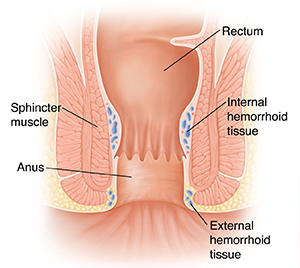
Presentation: Internal piles generally present as bleeding while or after passing stools like a splash in the pan and painless swelling, which may be prolapsed. External piles are painless tags around the anal opening with no associated bleeding. External piles when inflamed or thrombosed are painful.
Diagnosis: It is diagnosed based on patient complaints, per rectal examination and proctoscopy (internal piles).
Grade 1: The internal hemorrhoid bulges into the anal canal but does not prolapse or fall completely into it.
Grade 2: The hemorrhoid protrudes past the anal verge with straining for a bowel movement or passage of flatus but spontaneously return to their original internal position once the straining has subsided.
Grade 3: The hemorrhoid may protrude past the anal verge without any straining and requires the patient to push them inside manually.
Grade 4: Prolapsed hemorrhoids
Treatment: It is based on the grade of the pile.
Grade 1 can be treated with dietary and lifestyle changes.
Grade 2 are treated by office procedures (band ligation or sclerotherapy)
Grade 3 and Grade 4 piles require surgical management.
FAQ's
Majorly, piles are not associated with pain. Thrombosed external and internal piles are painful.
Early piles as in Grade 1 or early Grade 2 can be treated by dietary modifications, flavonoids, stool softeners (which prevent straining).
Indications for surgery are:
1. Severe bleeding.
2. Prolapsed piles.
3. Thrombosed piles
Modified Closed Hemorrhoidectomy.
